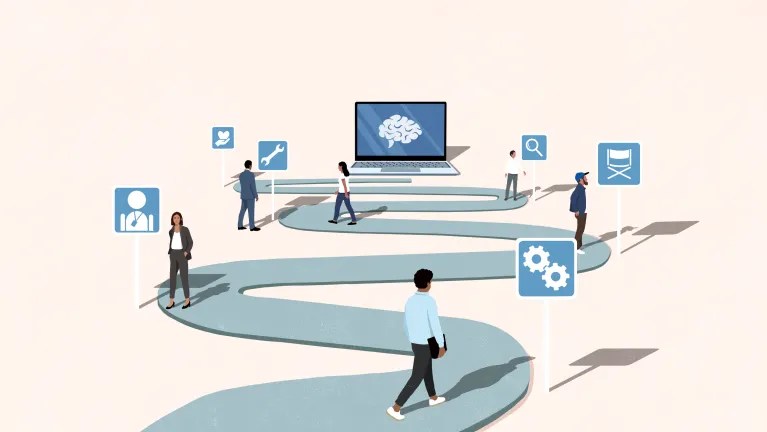AI Isn’t Taking Your Job — It’s Setting You Up For a Better One (Here Are 12)

AI and generative AI are helping create a variety of new careers, from prompt engineer to AI trainer. Here are 12 new and upcoming roles, and tips for how to prepare for them.
Everything. Everywhere. All at once. Yes, it’s an Oscar-winning movie, but it also perfectly describes the impact artificial intelligence (AI) is having on businesses, including the job market.
The 360 view
According to McKinsey, generative AI has the potential to add between $2.6 trillion and $4.4 trillion in value to the global economy across all industries, including banking, retail, high tech, healthcare, and life sciences. It will affect vocations such as customer operations, marketing and sales, software engineering, and research and development.
And while there’s been much fear around AI taking our jobs away, the new technology will, in fact, give rise to myriad new jobs for human beings. For example, high-paying roles like prompt engineer — essentially, a master of the art of crafting prompts for GPT interfaces — and AI product manager are currently trending on popular job search sites.
According to a recent Salesforce-sponsored IDC white paper of 500 organisations using AI-powered solutions, the next 12 months will also see a sharp increase in hiring for data architects, AI ethicists, and AI solutions architects. That same report predicts 11.6 million new jobs will be created within the Salesforce ecosystem alone over the next six years.*
What you can do now
AI needs people in control in order for it to work properly within our society. And members of the workforce, like you, have the opportunity now to hone existing skills across various industries and learn new skills to grow with the economy.
“The exciting thing about these tools is they’re nascent and they’re largely democratised,” said David Berthy, senior director of Salesforce Futures. “So, if people have the volition, they can go out and learn how to increase their own value.”
Platforms such as Salesforce’s Trailhead, Coursera, LinkedIn Learning, and Udemy all offer free and paid certification courses for in-demand AI-related skills.
Learn new AI-related job skills
From understanding the basics of AI to writing better prompts, numerous free courses exist on Trailhead, Salesforce’s online learning platform, to help you get ahead in the world of AI and generative AI.



AI will eliminate repetition and create new skills and roles
Let’s start by clearing something up: Yes, AI will likely eliminate repetitive job functions — scheduling social media posts, sifting through resumes, poring over data, answering basic customer service questions, sending follow-up emails — but that will free up people to be more strategic, creative, and productive in their current roles.
People will now have time to, well, be people. If you’re in sales or customer service, you can now devote more time to interacting with customers to create even better relationships. In marketing? You can spend more focused time on strategic thinking or creative projects. And if you work in the legal or healthcare fields, AI can help analyse and research contracts or help interpret MRIs and X-rays, respectively.
Not all new AI jobs will be as obvious as those in engineering or data-related fields. Jobs in healthcare, finance, graphic design, and more will evolve thanks to the assistance of smart AI.
“AI will be sort of a background to everything,” said Chris Poole, AI technical consulting lead in Salesforce’s global AI practice in professional services. “I think it’s going to be very interesting to see.”
How generative AI is creating new careers — 12 roles to consider
What’s new and interesting to the AI curious? Here are a dozen jobs to look out for — some that currently exist (if only in early iterations), and some that Berthy envisions existing in the near term. Is one in your future?
Prompt engineer
Prompt engineers excel at writing prompts for AI tools, like a GPT product or chatbot, to get the most accurate or desired results. Some refer to prompt engineering as “AI whispering” because you’re essentially guiding the generative AI product to give you a creative solution to your question or prompt.
AI trainer
An AI trainer works behind the scenes to make sure an AI algorithm does what it’s supposed to do. The trainer prepares heavy data sets to teach chatbots how to think and interact with user inputs so the AI responds with more natural-sounding human language. Trainers also fine-tune the data and systems to achieve proper outcomes. Simply put: “AI trainers teach AI systems how to think, interact, and be genuinely useful,” according to Boost.AI.
AI learning designer
As AI technology rapidly grows and changes, organisations will need people to optimise personal learning at scale, Berthy said. Not only will these roles help train people on AI systems and how to work alongside AI copilots, but they’ll also refine the ways in which people learn. “Companies that have better versions of [learning systems] will be better equipped to adapt these new technologies,” Berthy said.
AI instructor
As companies continue to implement AI technologies, someone will need to teach employees how to use them. AI instructors teach people the skills they’ll need to advance their careers, whether directly or indirectly involved with AI. They’re responsible for developing curriculum and teaching methods, leading hands-on classes and lectures, and more around AI education.
Sentiment analyser
Even though it can understand and interpret human language, AI is not human and does not have feelings. It doesn’t understand nuance and it can’t interpret emotion. That’s where a sentiment analyser comes in. They work with a sentiment analysis program to determine whether data pulled off the internet, like social media comments or product feedback, is positive, negative, or neutral, and to identify its emotional tone.
Stitcher
A stitcher is a generalist who uses AI to combine a range of skills held by multiple roles into one role or workflow. For example, this job will use AI to more quickly stitch together modular software tools into workflows that create unique value for customers, Berthy said. So, instead of having multiple people work on a project from design and storytelling to engineering and overall business implementation, the stitcher will tackle it all by using AI.
Interpersonal coach
This role will help people living and working in a digital-first world and working with AI to gain basic interpersonal skills like relational intelligence, empathy, active listening, and connecting in face-to-face interactions. It’s similar to a business coach, but focused on helping people who work behind a screen or mostly with machines.
Workflow optimiser
This role will use data and intelligence to have a bird’s-eye view across a company, and determine where AI could help people be more productive. This person will use AI to review how people and teams work, and highlight productivity gaps to increase overall efficiency.
AI compliance manager
As AI regulations continue to get refined globally, an AI compliance manager ensures an organisation’s AI processes adhere to relevant regulations, ethical standards, and industry guidelines. They make sure data-handling practices align with privacy laws and also mitigate AI’s potential impact on an organisation.
AI security manager
If AI technology gets into the wrong hands, it can quickly become dangerous. The AI security manager will be an important role within an organisation to ensure AI systems are used properly. They’ll also protect against vulnerabilities and security threats.
Chief AI officer
The newest role to enter the C-suite, the CAIO sets the overall AI strategy for an organisation. This includes the responsible and ethical design, development, and implementation of all AI tech produced by the company.
Chief data and analytics officer (CDAO)
The chief data and analytics officer oversees all things related to data and analytics in a company. Sometimes this role is shared by two people, one as chief data officer (CDO) and the other as chief analytics officer (CAO).
How to prepare for new AI careers
With all of these new AI jobs emerging, it’s time to embrace training and start playing around with the free tools at your disposal.
“Don’t be afraid of the tools,” Poole said. “Look at it as a helper that can improve your way of life and your work.”
Online learning platforms are making it easier to access these tools and skill up, said Aleksandra Radovanovic, senior product manager of business technology at Okta, a cloud-based identity management service that provides single sign-on solutions for businesses. She said to identify relevant skills and look for online courses to help build them. Trying to gain practical experience, even through certification courses, will also help.
“The people who embrace the changes and the opportunity they create and increase their own learning are the ones who will have the brightest futures,” Berthy said. “You can capture that ethos and give people some hope because there’s enormous opportunity to up your own marketability.”
Map Your Journey to AI-Powered CRM
Salesforce commissioned Forrester Consulting to speak to over 700 global business leaders for their take on succeeding with AI for CRM.



*Salesforce Economic Impact: Salesforce AI-Powered Cloud Solutions Will Generate $948 Billion in New Revenues for Customers by 2028 (doc #US51404923, December 2023)






















